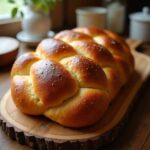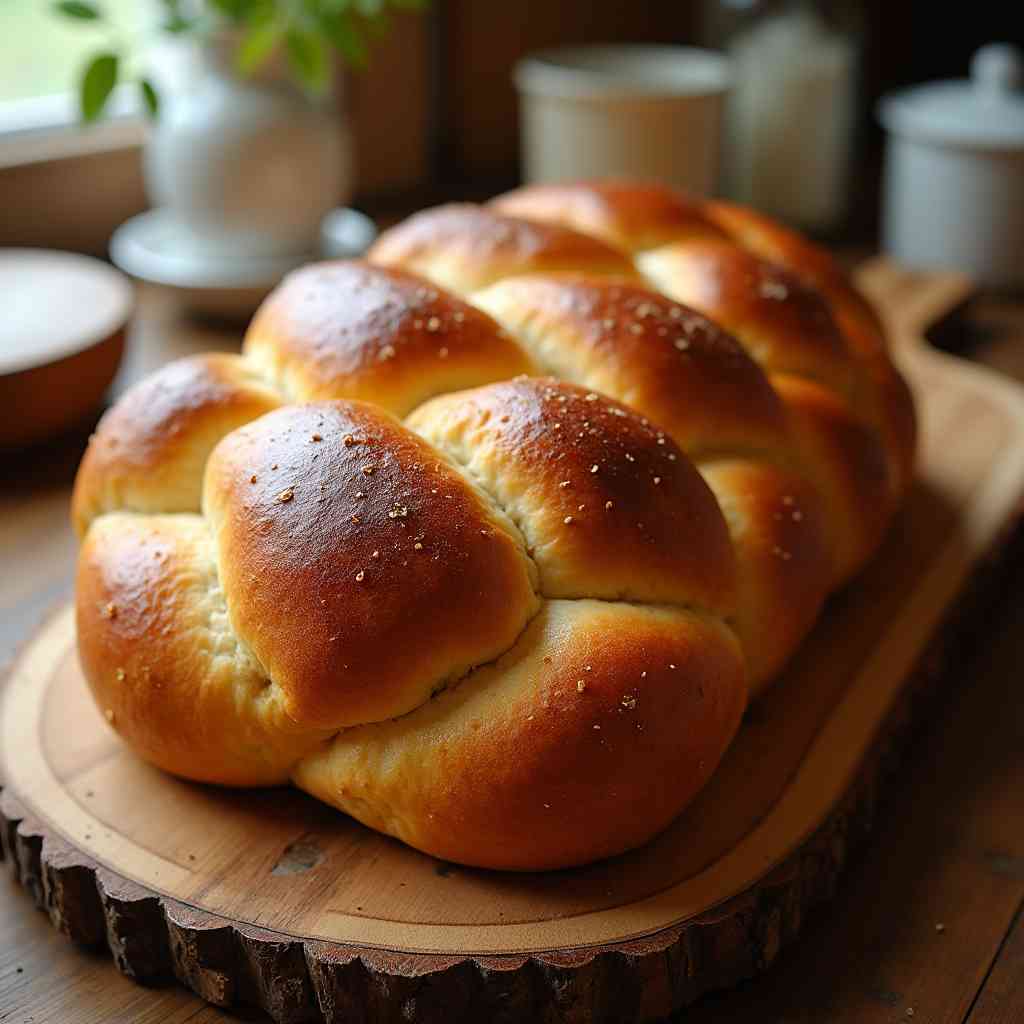Mennonite Easter Bread recipe is a cherished tradition that brings family and friends together every spring. This sweet, braided loaf rich with butter, eggs, and warm spices, symbolizes renewal and community.
In this article, you’ll discover exactly what makes this recipe special, how to create it step by step, and pro tips to achieve that perfect golden crust. By the end, you’ll not only have a foolproof recipe but also feel connected to centuries of Mennonite heritage. Let’s dive in!
Table of Contents
What Makes Mennonite Easter Bread Recipe Special?
Unlike ordinary sweet breads, Mennonite Easter Bread carries a story in every bite. Passed down through generations, this loaf blends simple, high-quality ingredients—like farm-fresh eggs and whole milk—with a pinch of cinnamon and vanilla for a subtle warmth. Personally,
I love how the dough transforms when kneaded by hand: it becomes silky and elastic, almost meditative. Expert bakers will tell you that letting the dough rise slowly, sometimes overnight in a cool spot, creates unparalleled depth of flavor. Plus, the braided shape isn’t just decorative; it represents unity and faith. Every time you bake it, you’re honoring a time-honored ritual that’s been shared at family tables for centuries.
How to Make Mennonite Easter Bread Recipe Step by Step
- Prep time: 30 minutes
- Rise time: 2–3 hours (including initial and second rise)
- Bake time: 25–30 minutes
- Total time: About 4 hours (including rising)
- Yields: One 2-pound loaf (8–10 slices)
In a nutshell, you’ll warm milk and butter, mix with yeast, sugar, and eggs, add flour and spices, knead until smooth, let the dough rise, braid, and then bake until golden. But the magic lies in the details—read on for the full story.
Print
Mennonite Easter Bread
- Total Time: 4 hours
- Yield: 1 loaf (8–10 slices) 1x
- Diet: Vegetarian
Description
A cherished spring tradition, this sweet, braided Mennonite Easter Bread is rich with butter, eggs, and warm spices, perfect for sharing with family and friends.

Ingredients
- 1 cup whole milk, warmed to 110°F (43°C)
- ½ cup unsalted butter, melted
- 2¼ teaspoons active dry yeast (1 packet)
- ½ cup granulated sugar
- 3 large eggs, at room temperature
- 4–4½ cups all-purpose flour
- 1 teaspoon ground cinnamon
- 1 teaspoon vanilla extract
- 1½ teaspoons salt
- 1 egg white + 1 teaspoon water (for egg wash)
Instructions
- In a large bowl, mix warmed milk and melted butter. Sprinkle in yeast and 1 tbsp sugar. Let sit for 5–7 minutes until foamy.
- Whisk in the remaining sugar and eggs, one at a time.
- In a separate bowl, combine 3¾ cups flour, cinnamon, and salt. Gradually add to the wet mixture. Mix until the dough starts to pull away from the sides.
- Knead on a floured surface for 8–10 minutes, or in a stand mixer for 6–7 minutes, until smooth and elastic.
- Place in a greased bowl, cover, and let rise in a warm place for 1½–2 hours or until doubled in size.
- Punch down dough. Divide into 3 equal parts. Roll each into 16–18 inch ropes, braid, and tuck ends under. Place on a parchment-lined baking sheet or in a greased loaf pan.
- Cover and let rise again for 45–60 minutes until puffy. Preheat oven to 350°F (175°C).
- Mix egg white with water and brush over braid. Bake 25–30 minutes, rotating halfway through. Bread is done at 190°F (88°C) internal temp or when it sounds hollow.
- Cool on a wire rack for at least 30 minutes before slicing and serving.
Notes
Use fresh ingredients and don’t rush the rising process for best flavor. Tent with foil if browning too quickly. Optional: dust braid with flour before rising for a rustic look.
- Prep Time: 30 minutes
- Cook Time: 30 minutes
- Category: Bread
- Method: Baking
- Cuisine: Mennonite
Nutrition
- Serving Size: 1 slice
- Calories: 220
- Sugar: 8g
- Sodium: 180mg
- Fat: 7g
- Saturated Fat: 4g
- Unsaturated Fat: 2g
- Trans Fat: 0g
- Carbohydrates: 32g
- Fiber: 1g
- Protein: 5g
- Cholesterol: 45mg
How to Store Mennonite Easter Bread Recipe for Freshness

To keep your Mennonite Easter Bread soft and delicious:
- Room Temperature (1–2 days):
Wrap the cooled loaf tightly in plastic wrap or store it in a large resealable plastic bag. Place it in a cool, dry spot—avoid direct sunlight or heat sources. - Refrigeration (Up to 1 week):
If you know you won’t finish it quickly, slice the bread and store individual slices in a sealed container. Refrigeration can slightly dry out the bread, so consider briefly toasting or warming slices before serving. - Freezing (Up to 3 months):
Slice the loaf, wrap each slice in plastic wrap, then place the wrapped slices in a freezer-safe bag. To thaw, leave slices at room temperature or pop them directly into a toaster or oven (set to 325°F/163°C) for a few minutes until warmed through.
Pro Tip: If you dust a little extra flour on the braid before the first rise, it creates a rustic, farmhouse look once baked. It also helps prevent sticking during the second rise.
More Related Recipes/Articles
If you enjoyed this recipe, you might love exploring these posts for other traditional delights:
- Mennonite Paska Recipe – A rich, eggy Easter bread with a smooth glaze and colorful sprinkles, perfect for holiday gatherings.
- Mennonite New Year’s Cookies – Crispy, buttery cookies flavored with rum and walnuts, a festive treat to ring in the new year.
- Check out more inspirations on our Medium blog and discover vivid recipe ideas on our Pinterest board.
FAQs
Can I substitute milk with a non-dairy alternative?
Yes, you can use full-fat coconut milk or unsweetened almond milk, but keep in mind that the flavor and texture might be slightly different. Coconut milk adds a subtle tropical note, while almond milk yields a lighter crumb. Always warm the substitute to 110°F/43°C for proper yeast activation.
Can I make this bread ahead of time for Easter breakfast?
Absolutely! For best flavor, prepare the dough the evening before. After the first rise, punch it down, reshape, and refrigerate overnight. The next morning, let it come to room temperature (about 45 minutes), shape and braid, then proceed with the second rise and baking.
What can I serve with Mennonite Easter Bread?
This bread is delicious on its own, but pairing it with homemade jam, clover honey, or softened butter elevates the experience. Try serving it alongside a cheese platter or fresh fruit salad for a festive brunch. Personally, I love to top warmed slices with a thin layer of apricot preserves—trust me, you’ll see the difference!


Yummy, best amish recipe, thx